

Introduction to Mathematical Philosophy. Competitive Strategy. TechniCity. Introduction to Systematic Program Design. About the Course Phones, diesel engines, animated newspapers, medical devices, games, political campaigns, medical research, mining, transportation systems, ... and so on, and on, and on... every day more of the world around us is at least partly run by computer programs.
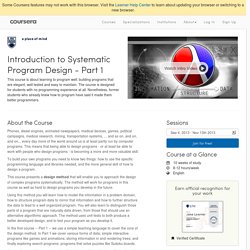
This means that being able to design programs - or at least be able to work with people who design programs - is becoming a more and more valuable skill. To build your own programs you need to know two things: how to use the specific programming language and libraries needed, and the more general skill of how to design a program. This course presents a design method that will enable you to approach the design of complex programs systematically. The method will work for programs in this course as well as hard to design programs you develop in the future.
In the first course -- Part 1 -- we use a simple teaching language to cover the core of the design method. Introduction to Guitar. Machine Learning. Machine learning is the science of getting computers to act without being explicitly programmed.
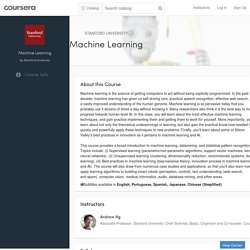
In the past decade, machine learning has given us self-driving cars, practical speech recognition, effective web search, and a vastly improved understanding of the human genome. Machine learning is so pervasive today that you probably use it dozens of times a day without knowing it. Many researchers also think it is the best way to make progress towards human-level AI. Writing II: Rhetorical Composing. The Hardware/Software Interface. Startup Engineering. Scientific Computing. Model Thinking. This course will consist of twenty sections.
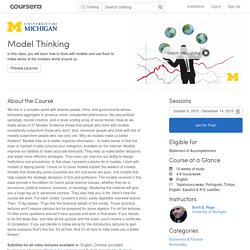
As the course proceeds, I will fill in the descriptions of the topics and put in readings. Section 1: Introduction: Why Model? In these lectures, I describe some of the reasons why a person would want to take a modeling course. These reasons fall into four broad categories: Computational Investing, Part I. OverviewWhy do the prices of some companies’ stocks seem to move up and down together while others move separately?

What does portfolio “diversification” really mean and how important is it? What should the price of a stock be? How can we discover and exploit the relationships between equity prices automatically? Computational Neuroscience. About the Course This course provides an introduction to basic computational methods for understanding what nervous systems do and for determining how they function.
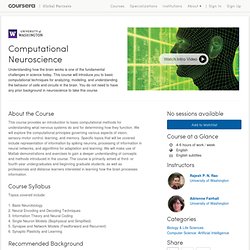
We will explore the computational principles governing various aspects of vision, sensory-motor control, learning, and memory. Specific topics that will be covered include representation of information by spiking neurons, processing of information in neural networks, and algorithms for adaptation and learning. We will make use of Matlab demonstrations and exercises to gain a deeper understanding of concepts and methods introduced in the course.
The course is primarily aimed at third- or fourth-year undergraduates and beginning graduate students, as well as professionals and distance learners interested in learning how the brain processes information. Course Syllabus Topics covered include: 1. Recommended Background Familiarity with basic concepts in linear algebra, calculus, and probability theory. Computational Methods for Data Analysis. General Game Playing. A Beginner's Guide to Irrational Behavior. Web Intelligence and Big Data. Human-Computer Interaction. Learn to Program: Crafting Quality Code. About the Course Most programs are used for years and are worked on by many people.
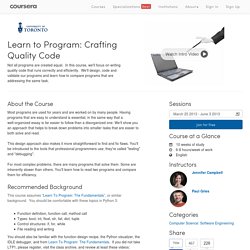
Having programs that are easy to understand is essential, in the same way that a well-organized essay is far easier to follow than a disorganized one. We’ll show you an approach that helps to break down problems into smaller tasks that are easier to both solve and read. This design approach also makes it more straightforward to find and fix flaws. You'll be introduced to the tools that professional programmers use; they're called "testing" and "debugging". For most complex problems, there are many programs that solve them. Recommended Background This course assumes “Learn To Program: The Fundamentals”, or similar background.
Suggested Readings Click to purchase We are writing a textbook that matches the course material closely, and includes different examples and exercises than the ones you'll encounter in this course. This title is currently available in Beta. Course Catalog. Gamification. About the Course Gamification is the application of digital game design techniques to non-game contexts, such as business, education, and social impact challenges.
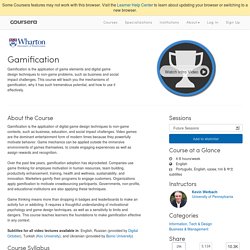
Video games are the dominant entertainment form of modern times because they powerfully motivate behavior. Game mechanics can be applied outside the immersive environments of games themselves, to create engaging experiences as well as assign rewards and recognition. Over the past few years, gamification adoption has skyrocketed. Social Network Analysis. About the Course Everything is connected: people, information, events and places, all the more so with the advent of online social media.
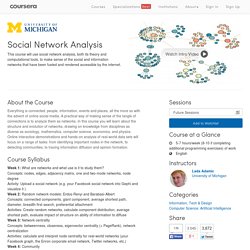
A practical way of making sense of the tangle of connections is to analyze them as networks. Songwriting. About the Course There’s a songwriter lurking somewhere inside you, peeking around corners, wondering if it’s safe to come out.

Now it is. This course is an invitation to let your inner songwriter step into the sunlight. All it takes is a simple “yes” and you’ll be climbing that windy hill, marveling at the view. If you haven’t written any or many songs, this course will show you an efficient, effective process for tailoring songs to express your ideas and emotions. The course will start by examining the tools available to you, all revolving around the essential concept of prosody. You’ll be working both lyrically and musically, though musically it’s not necessary that you either read music or play an instrument.